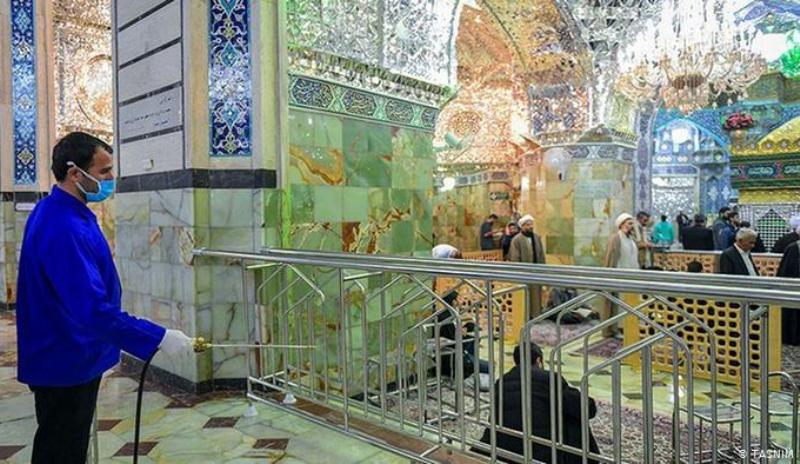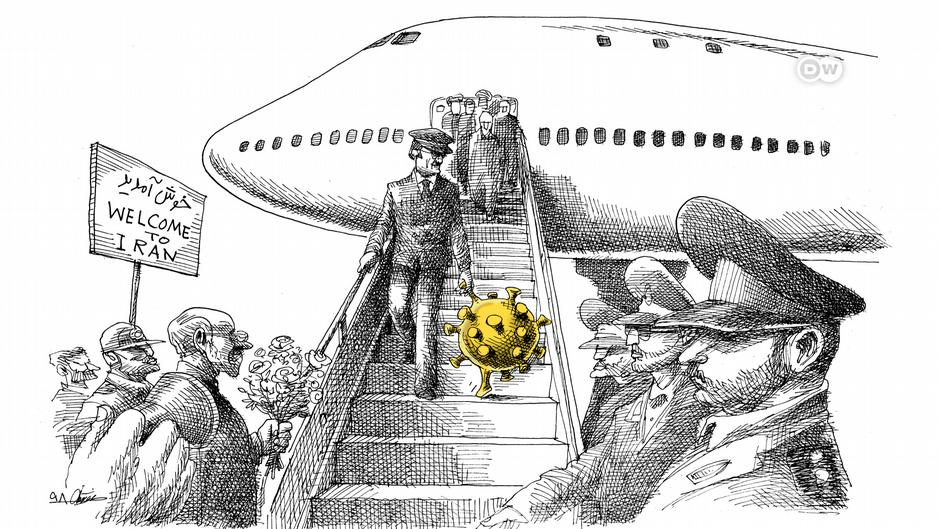Faith and the coronavirus

Omnipotent and omnipresent: at breakneck speed, the novel coronavirus in Iran has eliminated everything that makes up the Islamic state – Friday sermons, pilgrimages, visits to mosques, gatherings of mourners, seminars by the ayatollahs and state-organised street parades, both religious and political.
Yet the Islamic Republic is unimaginable without these highly symbolic mass events. Indeed it virtually no longer exists, at least not in the way it has presented itself to the rest of the world for 41 years. Even the clerics have disappeared from the streets. They are either in domestic quarantine or in hospital.
Since last Sunday a YouTube clip has been causing a furore in Iran: at the airport on the island of Kish in the Persian Gulf, a crowd of people are demonstrating against the arrival of 300 mullahs from the city of Qom who want to escape the virus and seek refuge on the warm island.
Plague in a holy place
After all, Qom – the "holy" city and pilgrimage destination of twenty million believers annually – was the starting point of the coronavirus epidemic in Iran. The first two deaths occurred in Qom. For weeks, images and reports had been making the rounds on social media, showing how the virus was spreading rapidly throughout the city. Travellers from Qom reported full waiting rooms and overcrowded hospitals in the city.

The first official reaction was that this was just fake news, trumped up by enemies seeking to sully Islam. That Qom of all places, the centre of Shia scholarship, should be the hotspot of the COVID-19 epidemic, that this plague should have started in this haven of holiness? Impossible, unthinkable. Such a lie – an insult to faith, God and conscience – could only have been invented by enemies of the Islamic Republic. But regardless of the denials and the clericsʹ holier than thou attitude, Iran's Qom is now on a par with Wuhan province in China. An explosive issue, politically and religiously.
Today Qom may be in the news because of the coronavirus epidemic. But the city was and remains – for the time being, at least – the beating heart of political Shia. Ayatollah Ruhollah Khomeini taught in this city for decades. It was in Qom that the Islamic revolution began, and it is here that those clerics who hold key positions in the Islamic Republic are trained today.
In Qom, 40,000 foreign seminary students are currently studying Shia theology. Subsequently they are supposed to promote Shia Islam with missionary zeal in their home countries and, if necessary, fight for it. Seven hundred of them are from China. Truly, the soul of the Islamic Republic resides in Qom.
Yet surely God would never allow the inhabitants of such a city to be afflicted by such a terrible plague. On 17 February, Gholamerza Jalai appeared in front of the television cameras in the uniform of the Revolutionary Guard, spoke about the God-given immunity of the holy city and categorically denied everything that was already an open secret: there was not a single coronavirus case in Qom or anywhere else in the country. Jalai should know; he is the head of Iranian civil defence. But the lies and denials did not last long.
Seventy-two hours later, the deputy health minister reported the death of two people infected with COVID-19 in Qom. Three days later, 12 people were dead, but only 47 infected. No one believed these numbers. On the same day, Assadollah Abasssi, a parliamentary representative from Qom, told journalists that he had personally given the names of 50 coronavirus deaths to the deputy minister. The latter replied that Abasssi should prove that these deaths had indeed been caused by the virus. The deputy minister has since disappeared from public view, because he himself became infected with COVID-19.

The tissue of lies surrounding the shooting down of the Ukrainian passenger plane by the Iranian Revolutionary Guard on 8 January lasted only three days. The coronavirus fairy-tale lasted several weeks. The reason: for one thing, there was no pressure from abroad. Secondly, the rulers had two important dates in this period for which they needed organised crowds: 9 February – the anniversary of the revolution – and the parliamentary elections on 21 February.
Once these important dates had passed, a few journalists and doctors dared to ask whether one should not learn from the Chinese and quarantine the city of Qom. A wave of outrage, a deafening outcry from the most influential ayatollahs immediately swept across the country – and the questioners fell silent. The sick of this world sought and found healing and health at the shrine in Qom, no one was allowed to quarantine the holy city, said Ayatollah Saidi, the Supreme Servant of the holy shrine.
So Qom remained accessible to everyone, the virus had free rein. And thus it spread rapidly throughout the country. Thirty-one provinces of Iran are now affected. Gilan and Mazandaran, the two northern Iranian provinces on the Caspian Sea, have now replaced Qom and are now the most dangerous places for the virus to spread.
Powerlessness wherever you look
Whether the rulers in Tehran can cope with this drama and how is difficult to predict. In its more than 40-year history, the Islamic Republic has lived constantly in and from crisis. But the coronavirus crisis surpasses everything that has gone before, because it has struck the country when it was already in desperate straits. To all intents and purposes, the regime is diplomatically and economically isolated, and now an epidemic quarantine has been added to the mix. Every one of Iran's borders with its neighbouring countries is sealed. This is a turning point in the history of this hybrid state, which calls itself a republic.
Future generations will certainly perceive this epidemic as a milestone and a profound caesura in the history of the Islamic Republic. One will read how influential ayatollahs first encouraged the spread of the virus and later declared it as possibly bioterrorism against the Islamic Republic. One will read in the history books how some mullahs travelled all over the country to promote Western medicine and Islamic medicine, and how the security forces forbade the living to speak about the numbers of the dead.
More importantly, through these stories, the survivors will recognise the great gulf that has opened up between reason and superstition, and will learn of the loss of confidence that has spread even among believers.
The impact of COVID-19 on Iran’s state religion is likely to occupy many people for a long time. Because the coronavirus isn't just killing people. It is also attacking the very sanctities on which the peculiar state system called the Islamic Republic is based. There will be a pre-corona period and a post-corona period in Iran. Nothing will ever be the same again.
If the Europeans in the Middle Ages regarded the plague as divine retribution for human sin, if at that time religious end-time madness was rampant, if flagellants marched through the country and whipped themselves as a sign of their atonement, or if one sought protection by turning to God and his servants on earth, then exactly the opposite is happening in Iran these days. People are fleeing the clerics. Every day new names of Shia scholars from Qom who have died of the coronavirus appear on social media. Up to now there have been twelve.
The king is not naked
The king is not naked. On the contrary. The people see him well protected and veiled via the Internet, even though he lives in secret. Since the virus officially arrived, Ali Khamenei, religious leader and the most powerful man in Iran, has only appeared twice and very briefly in the virtual world. Once, his personal doctor sat next to him, on a sofa and at a proper distance. The second time Khamenei was seen planting a tree in his garden, his shovel-holding hand protected by a plastic bag. It was the day of environmental protection.
The sale of alcohol has been authorised within Iran to improve and increase disinfection. State television is showing dancing and singing medical staff in hospitals to spread optimism: just two signs of the prevailing helplessness.
Nor is it clear who is ultimately responsible for combatting the coronavirus. On 11 March the President of Parliament asked Khamenei in a letter who should be in charge of the response team. Hassan Rouhani, Khamenei is said to have replied. But even the President of the Republic hardly appears in public anymore.
And even the Revolutionary Guards are in quarantine. Their barracks are the best protected places in the country, the news agency Fars quoted a commander as saying. They are apparently preparing for the time after coronavirus. Whether they will find the same country after that remains to be seen.
Ali Sadrzadeh